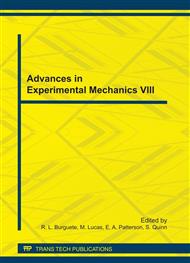p.369
p.375
p.381
p.387
p.393
p.399
p.405
p.410
p.416
Coupled Thermo Mechanical Characterisation of Polymers Based on Inverse Analyses and IR Measurements
Abstract:
Heat dissipation during mechanical testing can disturb experimental characterisation of polymers. In this work it is demonstrated that these effects are not limited to extreme loading conditions such as impacts. A visco-hyperelastic, visco-plastic constitutive model is proposed that accounts for thermo mechanical coupling in a fully 3D thermodynamics approach. Strain-rate and temperature dependencies are coupled using a concept close to the well known time-temperature superposition principle. Constitutive and coupling parameters are identified at the same time using an inverse analysis protocol. An experimental data base is generated for mechanical measurements at different temperatures and strain rates but also for temperatures during tests measured using IR technology. Such a protocol allows investigation on the strain-rate sensitivity in a much more relevant manner than classical one and the value of the so-called Taylor-Quinney coupling parameter is discussed.
Info:
Periodical:
Pages:
393-398
Citation:
Online since:
August 2011
Authors:
Price:
Сopyright:
© 2011 Trans Tech Publications Ltd. All Rights Reserved
Share:
Citation:


